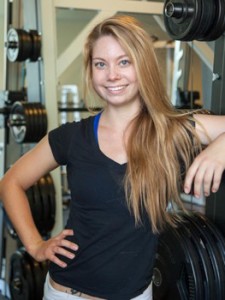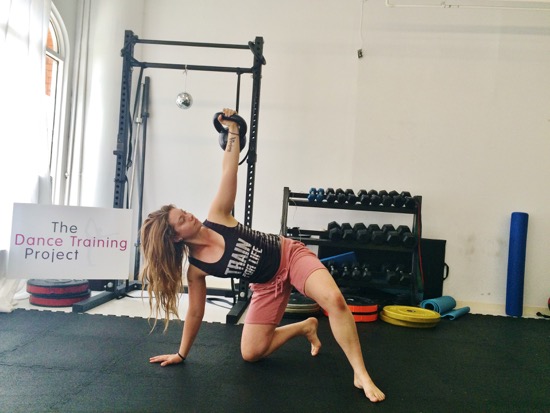Interview by Laura Donnelly

Monika Volkmar, is the creator of the Dance Stronger multi-media strength training resource for dancers. She is a graduate of the Ryerson University dance program and certified through the National Strength and Conditioning Association (NSCA) as a strength and conditioning specialist (CSCS). She is also a level 2 NeuroKinetic Therapy practitioner, Functional Movement Screen (FMS) certified, and a Thai massage therapist and teacher. Most recently Monika completed Anatomy in Motion training with Gary Ward.
After a series of injuries forced Monika to stop dancing, she became immersed in strength and conditioning, injury prevention, movement training, and Thai massage. As she studied then explored and incorporated new knowledge into her body, she healed herself. Realizing how much this information would have helped her “dance stronger” and avoid injuries when she was studying dance, Monika created this program to help dancers who want to enhance their technique and physical performance while minimizing soreness and injuries.
I met Monika online. I was searching for information on the necessity of building strength simultaneously with flexibility for my dance students. I found Monika’s article Stretches You Need to Stop Doing. It contained information I used that day in class. It worked so well that I bookmarked her blog and signed up to receive new articles from her.
In the summer of 2015, Monika issued a call for beta-testers for her Dance Stronger Program. She wanted a diverse group of people from current students and dancers, to older dancers, and dance teachers who would document their process as they went through the program. I volunteered and was excited to be part of the group. I’m no longer performing but need to stay strong and healthy to teach well. More importantly, I feel this work allows me to give my dancers information that helps them dance better, longer and with fewer injuries.
I interviewed Monika on Feb. 2, 2016.
LD: On your blog you often share your learning adventures, when you attend a new training, read a good book, or discover something in your own body through your personal movement practice. Please share some of your thoughts about life-long learning.
MV: Personally, what motivates me is always learning something new. Attending seminars reignites passion for what I’m doing. When I’m not learning anything I’m not as motivated by what I’m doing. Also, I think it’s good to keep up with what is on the “cutting edge”, learning what others in the industry are studying to best experiment with what works and what doesn’t.
I first got into this field (strength and conditioning, movement training and injury prevention) to learn how to help myself. Teaching what you’ve learned is a great way to solidify it in yourself. Seeing what I’ve learned applied in other people’s bodies, helps me to understand it for myself and for other people.
If you haven’t experienced something you don’t really know it, you only know what you can feel, and you can only see what you know, which makes it extremely important to first feel in your body what you wish to teach–try to understand it from the inside out to avoid conveying “corrupted” information. You can read all the research on something, and have the theoretical understanding, but you don’t really know that thing until you’ve felt it happen in your own body, and then have applied that to others and seen how it works in their bodies. I like when evidence and scientific research backs up experience.
LD: Will you speak about your commitment to help dancers be stronger and healthier?
MV: What inspired me to create Dance Stronger is that I’ve experienced so many injuries myself.
If I had known “then” what I know now, I think I could have minimized the stuff that I went through. If I had known important concepts like breathing and how it supports your strength, and recovery from injuries it would have been very helpful.
If I had known about how to manage my stress levels and how to recover, and if I had had a teacher that really promoted more biomechanically sound practices and was a bit more encouraging, I think that might have helped.
The biggest issue wasn’t that I was doing things in dance that were unsafe, because generally I didn’t try to do crazy tricks, like some other dancers who do a lot of excessive stretching and risky moves. I was definitely stretching more than I should have been, as many of my injuries were overstretching based, but even with all that, I truly feel that if I’d been in a bit better place mentally, and was a bit more grounded in who I was … I don’t know, there are so many factors correlating to injury in dance.
Definitely, if I’d been wiser in my practices, both in and out of class, it would have minimized my injuries.
LD: I saw from a recent blog post that you have just completed the Anatomy in Motion Immersion course. Please share how you think the AiM work will influence your work.
MV: In both the book portion and the Dance Stronger movement program there are things I want to update. I’d like to find a better way to convey this new information.
For example, I have learned things about foot function and I want to include those.
I hope to add some of the AiM exercises that have the potential to create some impressive differences in your body into the Dance Stronger program.
It’s challenging to figure out how to communicate the Anatomy in Motion concepts in detail without being there in person to ensure that people understand how the movements should feel.
It’s difficult doing this online. I want to give everyone as much information as possible so they can make the best-informed choices, but realize there are limits and challenges working with this medium.

LD: When did you start Dance Stronger? [Read more…]




